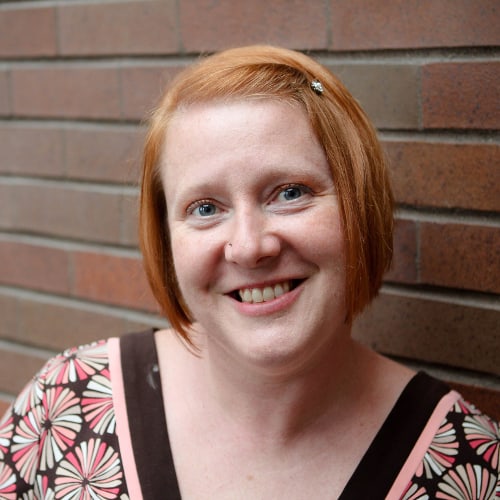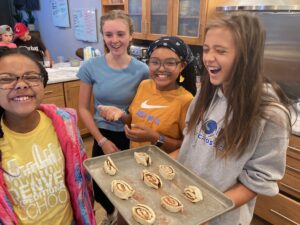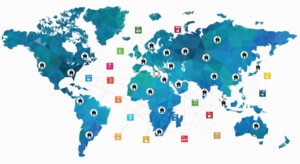Balancing Choice, Collaboration and Community

Writing is tricky business. It’s personal. It’s political. It needs to be scribbled in secret. It needs to be shouted from the rooftops. How in the world can teachers navigate these dichotomies? Then, just when you take a breath, confident you won’t fall off the tightrope we are all tiptoeing across, one must consider assessments. And honoring student choice. And embedding 21st-century skills like collaboration. Don’t forget that we are a global community too! No wonder so many teachers dislike teaching writing. To be honest, I’ve had years where I have too, unable to successfully balance so many seemingly divergent needs that are all somehow supposed to be met. However, I’ve had a change in perspective over the last few years, and I’d like to share a little about my own journey teaching writing that tries to balance choice, collaboration, and community.
Big Picture Thinking
When my daughter was about two, she went through this period of eating almost entirely sweet potatoes and cereal bars. As a first time parent, this kept me up at night. How would her brain develop if she was carb loading and spit anything green on the floor? When I asked the pediatrician about this problem, he said something that has stuck with me about parenting, but also has informed my teaching: “When it comes to children, you should take the longer view. It isn’t about what a child eats in a day, but the week, the month. Just keep trying new things on a regular basis.” The same is true about meeting every standard, skillset, and social-emotional competency as I teach writing. I’ve shifted my thinking from what a single assignment accomplishes to the broader view of the experiences I’m providing my students. However, this big picture thinking will only work if we keep trying new things on a regular basis.
Choice
For many years now I’ve run a Project-Based, Student-Centered classroom that is flexible to the needs of students academically, socially, and emotionally. (You can read the Getting Smart review of The Flexible ELA Classroom here, and The Flexible SEL Classroom here). At the center, of course, is choice. You can check out my website, flexibleclass.com for links to the assignments I use in my 8th-grade classroom. However, there’s been a nagging feeling that when it comes to writing, there are options that I haven’t explored, but this year I’m trying a new platform that is going to take choice to a whole new level for my students.
The platform is called WriteAbout. I first learned about it at the Association of Middle-Level Educators annual conference. It was my good fortune to meet Brad Wilson, a former teacher and Technology Integration Specialist, turned co-founder and CEO of WriteAbout, over lunch with a mutual friend and teacher (you can read about his start in the Getting Smart blog). When the conversation turned to differentiation, which it usually does with me, Brad popped open his laptop and showed me WriteAbout, which is now designed for K-12 students. The platform essentially allows teachers to invite students to join, enables grouping (which I’m going to call Writing Clubs) of students across classes and with other classrooms, and has a tremendous number of writing prompts that are teacher-generated, across genres. I’ve heard people say, “If you are reading and grading all of your student writing, they aren’t writing enough,” but I’ve never known quite what to do with that. In February, I’m going to find out! Students are going to set a word count goal, a number of times they need to comment on other writers’ work, and write a piece that they will later share in a celebration of writing. My assignment is a mix of NaNoWriMo and writer’s workshop. I’m able to see their progress, track important data for my principal, and they will write more than ever when they are responding in a way that more closely resembles their normal social media habits than Google Classroom, which I also use regularly. I’m looking forward to my students immersing themselves in writing in such an authentic way!
Collaboration
Before that though, we are going to be doing our Utopia project, which I’ve written about many times. The important part though, in terms of writing, is that my students work in groups and collaborate on an essay. This was a radical idea to me a few years ago, but with Google Docs, I saw it as the natural extension of group work. For those of you unsure how to “set this up,” you can see the assignment here. The number one question people ask is “do I grade them as a group?” Students receive three test grades: one for their parts of the essay, one for their presentation of their parts of the Google Slideshow, and a third for the entire team’s essay. At first students (and parents!) are leery of having students get the same grade, but I point out that as adults we frequently have to contribute to the same presentation. My bottom line is that there is interdependence–don’t put your name on anything you aren’t proud of, and if you aren’t proud of it, work together to get it right. That’s the real world (take a look at how this works in the business world and how it can impact education here).
Community
Broadening my definition of “community” only makes sense. WriteAbout has teacher settings that allow my students to share with our class, the world (with only a first name), and to post to other sites. As tempted as I am to keep it small, I know that the first time my students get comments from an authentic community of writers–people who want to respond to them, not have to for part of an assignment–I won’t be able to drag them away from their keyboards. My hope is that I’m able to expand my students’ community to reflect their reality–they will be working in a world where their community is inclusive, not siloed into classrooms. Getting Smart’s “Designing Student Projects for Global Readiness” extolls the benefits of widening students’ range of experiences, explaining that “Students develop empathy and global sensibilities, as well as connect with people of different cultures and communities across our world. Global readiness really facilitates a complex mind shift from “me” to “us.” Though my writing unit isn’t a “project” per se, it is an undertaking that requires the same type of mindset. WriteAbout is offering me an opportunity to take baby steps into releasing my students’ writing to the world, assuaging some of the normal trepidation when trying something new.
These shifts in thinking about writing are always fluctuating, but I’m starting to get the balancing act down. As the facilitator of my student’s learning, I do need to retain ownership of some aspects of their learning, but if I am to truly create writers who write things that the world will want to read, I’ve got to open the world up to them.
For more from Amber Chandler, see:
- Will the NFL Ever Use Robots, Not Humans
- Smart Review | An Epic! Review From a Teacher and Parent
- Would You Rather Be Traditional or Prepare Students for the Future?
Stay in-the-know with all things EdTech and innovations in learning by signing up to receive the weekly Smart Update.








0 Comments
Leave a Comment
Your email address will not be published. All fields are required.